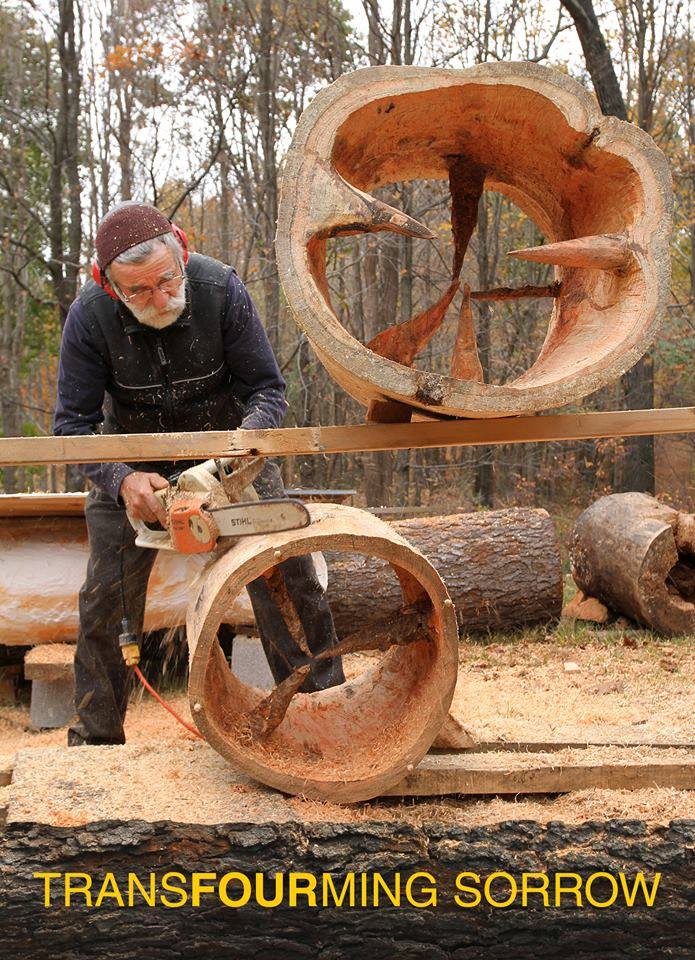‘Transfourming Sorrows that Bind Us to Transferences that Free Us’
LITCHFIELD, Conn.—Kardash Onnig’s installation Transfourming Sorrow celebrates the transferences that occur when two Others cross cultural borders to converge, find common ground, and arrive at new ways of seeing. The installation explores the wondrous possibilities of such convergences, inviting one into a multi-sensory experience of examples of the transferences of grief that have been channeled to Kardash and have transformed him and the Other. The installation takes place on both levels of The Wisdom Chapel on May 20–July 29. The “Womb of Sorrow” is on the main floor; “The Field of Transfourmation” is on the second floor.
Kardash Onnig’s personal transfourmation of sorrow is the result of his interactions with others who have suffered unspeakable losses: the death of a child, a suicide, war, ethnic cleansing and genocide.
Genocide survivor and poet Vahe Vahian was one of Kardash Onnig’s elementary school teachers. In his critically acclaimed book of poems, A Monument to My Son, Vahe Vahian laments the devastation wreaked by racial hatred and war, and mourns the death of his son in a car accident. In the end, what lends Monument its enduring beauty is the author’s aching desire to transcend his grief by “adopting” all victims as his own children.
Vahe Vahian’s lamentation is voiced in the “Womb of Sorrow,” an acoustic sanctuary featuring original music and voice that emanate from speakers handcrafted by Kardash. The speakers rest on a quaternary-motif kilim, woven and brought from Anatolia, Turkey, by the artist’s grandmother, who was also a genocide survivor.
Just as Vahe Vahian transformed sorrow by embracing the universal grief of all victims, in another example of the transference of grief, Kardash Onnig’s lawyer, who had lost his son to suicide, transformed a father’s grief by adopting and shepherding Kardash, gifting to him the land Kardash now lives on, Baraka.
Likewise, in a transformation of the terrible sorrow of ethnic cleansing, Kardash Onnig adopted the name Kardash (“brother” in Turkish) to honor the Turks who saved his grandmother during the Armenian Genocide.
Born in Zahleh, Lebanon, Kardash Onnig was named for his step-grandfather’s son, Onnig, whose mother died during childbirth. The infant Onnig survived just nine months after his mother’s death. Many years after this son’s death, the widower married Kardash Onnig’s grandmother. In his childhood, Kardash Onnig used think his name was “Lookslikeonnig” because that is what everybody said when they picked him up. This “adopting” of the Kardash Onnig was a transference of grief from the dead son to Kardash Onnig spanned three generations and transformed this family’s sorrow.
In “Field of Transfourmation” on the second floor of Wisdom House, Kardash Onnig’s personal transfourmation of sorrow is expressed in elemental forms representing the convergence of his four with an Other’s four, resulting in transferences of immense grief.
Kardash has studied numerous cultures across the globe, in search of commonalities in their symbologies and creation myths. He has discovered that a core symbol shared by all cultures and mythologies is the quaternary – the four elements as manifested in our existence: water, earth, air and fire; birth, growth, reproduction, and death; philosophy, spirituality, science, and the arts. His work deals with how these four elements (or lifelines) interact, influence one another, intersect, and synergize. His work is based on the premise that the principle of the four is a cornerstone of universal consciousness.
“In this installation, I share my transfourmation from the grief of having voluntarily abandoned my mother tongue’s alphabet, and later all alphabets, as tools for communication because of the binding two-dimensional linearity of their historiography,” says Kardash Onnig. At the heart of sorrow that bind us is an alphabet that, despite having been invented by the synergy of two luminaries from warring cultures 16 centuries ago, is seen as woefully two-dimensional by the artist.
“I had to invent three dimensional universal tools to express my transfourmations – to free myself.”
Now based in Hudson Valley, New York, Kardash – sculptor, inventor, toymaker, author, and activist – has worked in the community and exhibited worldwide for over 45 years. He has spent years investigating “transferences of energy” in the pursuit of developing universal, three-dimensional “tools” for communication. In terms of conviction and design alike, the “tools” created by the artist aim to transcend cultural boundaries and the rigid two-dimensionality of national alphabets and cultural barriers, in an overarching effort to help foster transferences between two Others.
The Transfourming Sorrow installation also comprises a parallel exhibition of Kardash’s sculptural works in the art gallery of Wisdom House Chapel. The works featured at this exhibition consist of 110 Talismans, and four fertility pieces celebrating his grandson’s growth in the womb. The Talismans are made with clay dug from Baraka, the plot of land in Stanfordville where Kardash lives and works. Each Talisman represents a transference with an Other formed by the synergy of a set of four “tools.”
Following the construction process, the Talismans were wrapped in natural materials obtained from the land and subsequently pit-fired with wood that was likewise obtained from the land – a ritual of connecting with the four elements. The Talismans are set on a Quaternary quilt that was sewn by Kardash’s mother using scraps from his father’s tailor shop.
The Transfourming Sorrow installation and adjacent exhibitions, curated by Tony Carretta, will open on May 20 and runs through July 29, at the Wisdom House Chapel in Litchfield, Conn. For more information about the exhibit, visit www.wisdomhouse.org or call (860) 567-3163. For more information about Kardash Onnig, visit www.kardashonnig.com.




















































